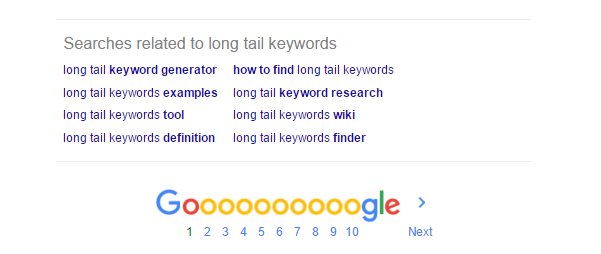Content marketing and SEO go hand-in-hand – one doesn’t work without the other. However, the rules of SEO constantly change, and only the companies that understand the power of content driven by SEO will see the financial ROI executive management looks at around budget renewal time. If you’re still creating content based solely on keywords and not paying attention to the wealth of big data audience information at your fingertips, your company is missing out on its potential in desktop and mobile search engines.
The Purpose of Keywords
Some SEO marketers believe keywords are the end-all-be-all of exceptional content marketing. They look at keywords first and everything else second. Other professionals, however, have started embracing the idea that valuable content comes first and that keywords only offer a tool to help search engines recognize meaningful content.
The basic purpose of keywords is simple: buzzwords for content. They’re the words or phrases that make your content pop up after a Google search query instead of another piece of content. Having the right keywords can improve your visibility online, drive traffic, and yield measurable results.
What Are Long-Tail Keywords?
Long-tail keywords take the concept of keywords to the next level. For instance, the keyword “chocolate” could refer to anything. Is it a puppy? Ice cream? A color for a leather purse? Long-tail keywords focus on specific queries instead of singular and generic keywords that never reach the right audience. Turns out my keyword “chocolate” was actually supposed to target wine connoisseurs. A better keyword phrase would be “red wine chocolate notes.”
The specificity of the phrase increases the likelihood that people actually interested in the content will see it. Relevant search engine visibility is much more powerful than generic placement.
Meeting in the Middle: Two Keyword Approaches
Google algorithms are getting better at recognizing relevancy and value, making it more important than ever for brands to focus on the substance of content as well as the right keywords. Remember the two approaches to keywords in content marketing? One starts with the keyword and the other starts with the content. Using a mixture of these methods will likely yield the best results. You need to know what phrases are trending in your market, but you also need to provide valuable content – which may impact your audience without making a top trends list.
Tips for Boosting SEO With the Right Content
- Use your company’s mission to drive content. Never produce something because you think it’ll lead to visibility. Generate content because it represents your brand and provides value. Use overall marketing strategy goals to match keywords with carefully developed material. Before you post anything, put yourself in a searcher’s shoes. If a user inputs your keywords, will the content you’ve provided satisfy his or her query?
- Identify keyword value. Use Google AdWords or a similar search engine marketing program to determine the click through rates and potential value of a keyword. Moz offers more detailed instructions on assigning dollar amounts to phrases. You can also try using a program like HitTail to identify traffic generating long-tail keywords that may help your website. These solutions aren’t free, but the value of understanding and using the right keywords typically earns more over time than it costs.
- Use a content first approach and a keyword first approach. Use a mixture of methods to ensure you have a well-rounded content profile for your brand. Develop material you know will impact your audience, and retrospectively find long-tail keywords that fit.Simultaneously, use high-quality keywords as a launching pad for the development of new content. With both approaches, you can maintain an incredible level of value while boosting overall SEO.
- Check out the bottom of a Google search page. If you input a keyword to see what type of content already exists, scroll to the bottom of the page for similar search phrases. These listings often include high quality keyword phrases searchers are using on the website. Try any of the terms that relate well to the content you’ve produced.

- Refresh existing content with impactful keywords. When you’re not focused on content generation, make sure your existing material doesn’t get lost in the noise. Go back into old posts to check links, change keywords, and update information.
- Use natural engagement to your advantage. While a strategic approach to SEO is clearly beneficial and profitable, natural or organic engagement online goes a long way. To reach any of your digital marketing goals, you need more than visibility; you need accessibility. Focus on placing material in areas where your target market naturally spends time. Gain market trust by engaging in social media conversations, sharing relevant content, and creating a relationship.
- Be specific. The internet has enough generic content floating around to last a lifetime. Focus on answering specific questions that give your company an edge over the competition. Precise content and keywords naturally draw in audience members who are more likely to convert. Use those niche postings and long-tailed keywords to your advantage. After all, the quality of your traffic is generally more important than the quantity.
Finding Balance in Content Marketing
You may feel overwhelmed with content development teams, SEO experts, executive management, and others all focusing on a unique aspect of digital marketing. Trying to maintain relevancy and connectivity online is a never-ending job, and keywords, content form and quality, and channel diversity represent an interconnected piece of the puzzle. You need it all to make an impact online. Without a multi-faceted approach, the individual efforts only move a business forward so far.
Research, develop, publish, and optimize – strategic work on content never ends, but that’s also job security. Whether you’ve never thought much about keywords or you’ve used them to drive everything, try some of these tips for creating more value and getting better results from the strategy you’ve worked so hard to develop.
Digital & Social Articles on Business 2 Community(66)









